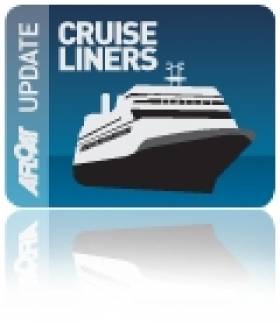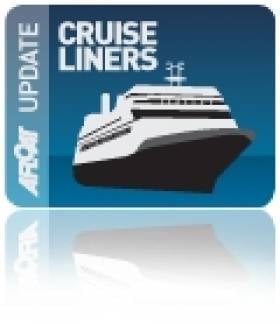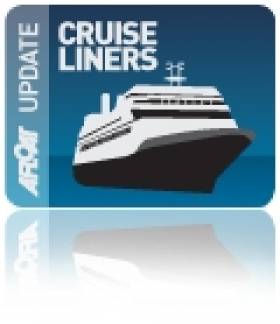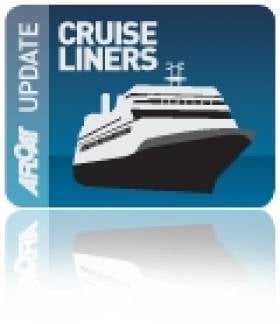Displaying items by tag: Boudicca
Cruise Liners To Dublin Port Carrying over 135,000 Passengers Bring €50 million Boost
#dublinport – Dublin Port Company marked the end of a successful cruise season for 2014 as the final cruise liner to visit Dublin this year, the "Boudicca", docked in Dublin Port early on Saturday morning. Cruise liners carrying over 135,000 passengers and crew to Ireland's capital city generated a major economic boost of €50 million during 2014.
"Boudicca" sailed in to Dublin Port at 9.30am having departed Liverpool the previous evening. Carrying over 1,200 passengers and crew, this was the 205 metre ship's fourth 'mini cruise' to Dublin this month. Her arrival in December highlights how Dublin Port's cruise season has been extended by an additional two months, bringing high-spend visitors and revenue to the city at a key trading period. The "Boudicca" passengers represent a more independent cruise traveller looking to experience the sights and sounds of the capital in the run up to Christmas.
Passengers were welcomed by the Lord Mayor of Dublin, Christy Burke, amidst a Winter Wonderland scene created on the quayside, before departing for the city's sights, shops and eateries.
Lord Mayor of Dublin, Christy Burke, said: "I am honoured to welcome the 1,200 cruise passengers who arrived in Dublin Port full of eager anticipation about their visit to the city. Dublin is a truly vibrant destination with a wealth of culture and cuisine, attractions and entertainment to offer passengers. I congratulate Dublin Port Company on its tremendous work to promote and cater for cruise tourism to Dublin. I am confident that Dublin has great potential to grow as a cruise destination and benefit the city's businesses even further."
Mr. Pat Ward, Head of Corporate Services, Dublin Port Company said: "This ship brings over 1,200 passengers and a welcome boost to Dublin just before Christmas, marking the end of a thriving cruise season at Dublin Port. Cruise is an important part of Dublin's tourism product and Dublin Port Company has worked hard to attract this valuable business to the city. The arrival of Winter cruises is a clear example of changing passenger patterns and demand for Dublin as Ireland's top cruise destination."
"It is essential that Dublin Port Company continues to facilitate passenger demand so that Dublin remains the port of choice for cruise. We are committed to investing in the necessary port infrastructure to achieve this, such as longer, deeper berths envisaged under our ABR Project. This type of investment will allow Dublin to flourish, giving larger ships, including cruise liners, the modern facilities they need to dock within striking distance of the city."
Liverpool Season Opens with a Cruise to the Canaries
#CruiseLIVERPOOL – Liverpool's first cruise caller of 2013 was Fred Olsen Cruise Lines Boudicca which made her maiden turn around call on Merseyside yesterday, writes Jehan Ashmore.
The afternoon arrival of Boudicca from Portsmouth was completed when she berthed alongside Liverpool Cruise Terminal with the assistance a tug at the riverside quay.
She remained at the facility until departing last night on a "Gardens and Beaches of the Canaries" cruise. The vessels (see web-tracking) first port of call is scheduled to be Arrecife, Lanzarote.
For a list of the Liverpool's cruise callers in which there are more than 40 calls this season, among them being Queen Mary 2, Queen Elizabeth and Celebrity Infinity click HERE.
First Cruise-Caller of the Year
Onboard the ship which caters mostly for the UK market, asides the interior facilities there are the outdoor leisure amenities located on the Lounge Deck which has two jacuzzis and an exercise pool. There is also a large swimming pool and weather permitting a poolside buffet is also available at meal times. In addition a circular pool is located on the Marque Deck.
She alongside sister Black Watch belong to a four-ship fleet of the Norwegian owned company. Boudicca was built in 1973 and for many years served as Royal Viking Star as part of a trio of German built sisters for Royal Viking Line. The 205m long vessel underwent her last major refit in 2006.
Boudicca will remain berthed in Dublin's Alexandra Basin until she sets sail later this afternoon for the short overnight cruise-leg to Liverpool.
Last year Dublin Port handled 88 cruisecalls and this number of cruise-callers is to be closely repeated in 2011. Overall there will be over 200 cruise calls with around half a million passengers and crew scheduled to visit ports and anchorage locations throughout the island of Ireland. The cruise sector business is estimated to generate €60m to both the northern and southern economies.
Frostbite 'Cruising'
This morning the 28,388 gross tonnes cruises-ship Boudicca is due to arrive into Dublin Port, writes Jehan Ashmore. The visit of the 1973-built vessel will represent the second last cruise-call of this year's cruise-season. The 900-passenger capacity Boudicca will depart later today on a 10-day cruise to include calling to Cork.
The final cruise-call scheduled for Dublin Port will once again by made by Boudicca on 20 November. On that cruise the Fred. Olsen Cruise Lines ship will be returning from Cork after an overnight passage.
Next year Dublin is to welcome 86 cruise-ships, where the largest of these vessels will berth in Alexandra Quay, located 2 kms from the city centre. Smaller vessels can dock closer to the city-centre but they have to transit the East-Link toll-road lift bridge. In addition the depth of water on the River Liffey also restricts the size of cruise-ship.
Incidentally the Boudicca will be the first caller to Dublin in 2011, with a morning arrival due on 9 April. For further information on next year's cruise-call season, a list is available online at www.dublinport.ie/not-in-menu/cruise-ship-scheduled/
Dublin and Cork Share Cruise-Calls Bonanza
The ports of Dublin and Cork are scheduled to receive a record 139 cruiseships in total this year, bringing 180,000 visitors and crew. Many more of these cruiseships are due to visit over the next two months and stretching into late Autumn. Between €35-55m is expected to be generated into the Dublin region from high-spend cruise visitors
while a further €5m is predicted for the local economy at Cork, writes Jehan Ashmore.
A notable visitor due to grace Dublin Bay is the return of The World, albeit not strictly a cruiseship but the first custom-built time-share ship. The vessel is to dock in the capital for four-nights from 4-8 August and then sails overnight to Cobh, for two-nights from 9-11 August.
In essence, The World presents an exclusively unique lifestyle experience. Instead of passengers, there are 'residents' who live onboard. Residents of the 43,188 gross tonnes (GT) vessel don't merely occupy a cabin but own large-sized luxurously appointed private apartments that are 'home' complete with balconies.
On 9 August, Silver Cloud docks at Dublin from Oban, Scotland. Measuring 16,927 GT, the vessel may not be the largest with only 315 passengers, but is an ultra-luxury cruiseship, regarded as one of the highest standards in the cruise-sector industry.
Returning to Cork Harbour, Cobh awaits the mighty Independence of the Seas. At 154,407 tonnes, she is the biggest ever cruiseship to dock at any Irish port. With a massive 4,375 passenger capacity, attractions include rock-climbing or surfing-boarding using a special pool. The 'Independence' berths mid-afternoon on 29 August for an overnight call, departing 18.00hrs the next day.
Among smaller cruiseships, the private-motoryacht like, Island Sky of 4,000 tonnes and with 200 passengers, calls to Dublin on 11 August, and may berth upriver close to the new Samual Beckett Bridge.
Those keen on traditional ships, can look forward to the visit of Classic International Cruises Princess Danae, built in 1955. The veteran is due 16 August, and her sister, Princess Daphne is expected 2 September. Unusually the 16,000 tonnes pair were converted from general cargo-ships for a career in cruising.
New cruiseship, Costa Luminosa (92,700 GT) costing US $ 548m makes a second call to Cobh on 3 September and is operated by Costa Cruises.
This is the first time the Italian company has ventured into Irish cruising waters.
Without doubt the largest Dublin caller this season will be Emerald Princess. The giant weighs some 113,000 gross tonnes and at 288m long will certainly provide a spectacle, with lights blaring over a dozen or so decks, during a dusk departure on 14 September.
Also entering service this year, P&O Cruises 116,000 tonnes new Azura, is set to visit Dublin on 23 September and Cork the next day. The Italian built newbuild cost US $ 535m and has a capacity for 3,076 passengers.
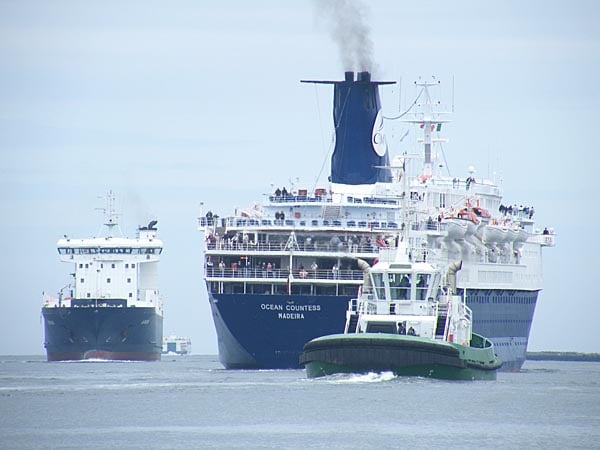
Ocean Countess departing Dublin. Photo: Jehan Ashmore/ShipSNAPS
A newcomer to Irish ports is Cruise & Maritime Voyages Ocean Countess which is making round Ireland itineraries with calls at Cobh on 13 August and 12 September. Incidently the 'Countess' was converted into a troopship for the Falkland Islands conflict in 1982.
Jewel of the Seas (90,090 GT) makes a Cobh call on 7 September and exactly a month later returns, marking the last cruise-call to Cork in 2010 while Fred Olsen's Boudicca will be Dublin's last caller on 20 November.
For further information on other visiting cruiseships, please click links:


























